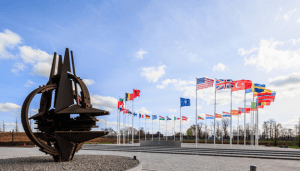TAG: GS 2: INTERNATIONAL RELATIONS
THE CONTEXT: The North Atlantic Treaty Organization (NATO) celebrated its 75th anniversary on April 4, 2024, reflecting on its historical significance, current challenges, and future prospects.
EXPLANATION:
North Atlantic Treaty Organization (NATO):
- NATO is a Western security alliance founded on April 4, 1949.
- NATO’s main headquarters are located in Brussels, Belgium, while NATO’s military headquarters are in Mons, Belgium.
- Its 12 founding members are Belgium, Canada, Denmark, France, Iceland, Italy, Luxembourg, the Netherlands, Norway, Portugal, the United Kingdom and the United States.
- They signed the Washington Treaty, which gets its power from Article 51 of the United Nations Charter, “which reaffirms the inherent right of independent states to individual or collective defence.”
- At the very heart of the alliance is the concept of “collective security” – an attack on any of the members is seen as an attack on all of them and demands collective action.
- This was deemed necessary in 1949 amid the Cold War rivalry between the then USSR and the US, over ideological and economic superiority.
- Article 5 of the Washington Treaty, on collective security, was added “to counter the risk that the Soviet Union would seek to extend its control of Eastern Europe to other parts of the continent.”
- The USSR also aimed to shore up allies and in 1955, the Warsaw Pact was constituted as an alliance of socialist countries.
- However, it doesn’t necessitate direct military intervention constituting all members.
- The scale of action is dependent on each member country “as it deems necessary”.
- The only time the article has been invoked so far was following the September 11, 2001 attacks on the US. NATO forces were sent to Afghanistan and deployed for nearly 20 years.
Membership
- Over the years, NATO has expanded its membership significantly.
- Originally the founding members were 12.
- NATO Member countries are:
- Albania, Belgium, Bulgaria, Bulgaria, Canada, Croatia, Czechia, Denmark, Estonia, Finland, France, Germany, Greece, Hungary, Iceland, Italy, Latvia, Lithuania, Luxembourg, Montenegro, Netherlands, North Macedonia, Norway, Poland, Portugal, Romania, Slovakia, Slovenia, Spain, Sweden, Türkiye, United Kingdom, United States.

Challenges Facing NATO
- NATO faces a multitude of challenges in the contemporary geopolitical landscape.
- One of the most pressing issues is the tensions with Russia, highlighted by Russia’s 2022 invasion of Ukraine, which many attribute at least partially to NATO’s expansion.
- This expansion has prompted direct confrontation, as acknowledged by Kremlin spokesperson Dmitry Peskov.
- Additionally, internal disagreements among member states pose challenges. Disparities in defense spending, as emphasized by former U.S. President Donald Trump, create strains within the alliance.
- Former U.S. President’s insistence on member countries meeting the 2% GDP spending target exacerbated tensions, leading to concerns about the future of the alliance.
- Furthermore, there are strategic divergences between European allies and the United States, as pointed out by French President, indicating a lack of strategic coordination within the alliance.
- These tensions are further exacerbated by issues such as human rights concerns, as evidenced by Turkey’s objections to the entry of Sweden and Finland into NATO.
Future Prospects
- Looking ahead, NATO faces a pivotal moment in its history.
- The ongoing conflict between Ukraine and Russia underscores the need for a cohesive and unified response from NATO member states.
- Efforts to enhance defense spending and strengthen collective security measures are imperative for the alliance’s continued relevance and effectiveness.
- Secretary-General has proposed plan to ensure that all NATO members meet the 2% spending target by the end of 2024 demonstrates a commitment to addressing internal disparities.
- Moreover, initiatives such as the proposed $107 billion fund for Ukraine signify NATO’s willingness to confront external threats and support partner nations in the face of aggression.
- However, uncertainties loom, particularly regarding the future trajectory of U.S. foreign policy under new administrations.
- The possibility of a return to isolationist tendencies, as articulated by former President, raises concerns about U.S. commitment to NATO and collective defense obligations.


